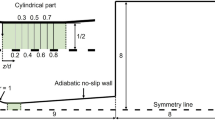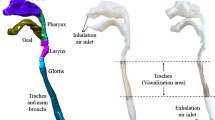Abstract
An investigation into influence of obstructions on premixed flame propagation has been carried out in a semi-open tube. It is found that there exists flame acceleration and rising overpressure along the path of flame due to obstacles. According to the magnitude of flame speeds, the propagation of flame in the tube can be classified into three regimes: the quenching, the choking and the detonation regimes. In premixed flames near the flammability limits, the flame is observed first to accelerate and then to quench itself after propagating past a certain number of obstacles. In the choking regime, the maximum flame speeds are somewhat below the combustion product sound speeds, and insensitive to the blockage ratio. In the more sensitive mixtures, the transition to detonation (DDT) occurs when the equivalence ratio increases. The transition is not observed for the less sensitive mixtures. The dependence of overpressure on blockage ratio is not monotonous. Furthermore, a numerical study of flame acceleration and overpressure with the unsteady compressible flow model is performed, and the agreement between the simulation and measurements is good.
Similar content being viewed by others
References
Chan, C., Lee, J. H. S., Moen, I. O. et al., Turbulent flame acceleration and pressure development in tubes, in Proceedings of the First Specialist Meeting of the Combustion Institute, Bordeaux, France, July, 1981: 479–487.
Moen, I. O., Donato, M., Knystautas, R. et al., Flame acceleration due to turbulence produced by obstacles, Combustion and Flame, 1980, 39: 21–32.
Moen, I. O., Lee, J. H. S., Hjertager, B. H. et al., Pressure development due to turbulent flame propagation in largescale methane-air explosions, Combustion and Flame, 1982, 47: 31–52.
Lee, J. H., Knystautas, R., Freiman, A., High speed turbulent deflagrations and transition to detonation in H2-Air mixtures, Combustion and Flame, 1984, 56: 227–239.
Hjertager, B. H., Fuher, K., Parker, S. J. et al., Flame acceleration of propane-air in a large-scale obstructed tube, dynamics of shock waves, Explosions and Detonations, 1984, 94: 504–522.
Lee, J. H., Knystautas, R., Chan, C. K., Turbulent flame propagation in obstacle-filled tubes, in 20th Symposium (International) on Combustion, Pittsburg: the Combustion Institute, 1984, 1663–1672.
Yu Lixin, Sun Wenchao, Wu Chengkang, Study on application of gas-pulse ash-cleaning technology, Journal of Combustion Science and Technology (in Chinese), 2001, 7(3): 223–227.
Thibault, P., Liu, Y. K., Chan, C. et al., Transmission of an explosion through an orifice, in 19th Symposium (International) on Combustion, Pittsburg: the Combustion Institute, 1982, 599–606.
Hjertager, B. H., Simulation of transient compressible turbulent reactive flows, Combustion and Technology, 1982, 27: 159–170.
Sarkar, S., Erlebacher, G., Huaasini, M. Y. et al., The analysis and modeling of dilatational terms in compressible turbulence, ICASE Report, 1989, 89–79.
Zeman, O., Dilatation dissipation: The concept and application in modeling compressible mixing layers, Phys. Fluids A, 1990, 2(2): 178–188.
Sarkar, S., The pressure-dilatation correlation in compressible flows, Phys. Fluids A, 1992, 4(12): 2674–2682.
Wilcox, D. C., Progress in hypersonic turbulence modeling, AIAA-91-1785, June, 1991.
Liang Dewang, Wang Guoqing, Modification of two-equation turbulence models with compressibility and its application, Acta Aerodynamic Sinica (in Chinese), 2000, 18(1): 98–104.
Haidinger, F. A., Friedrich, R., Numerical simulation of strong shock/turbulent boundary layer interactions using a Reynolds stress model, Z. Flugwiss. Weltraumforsch, 1995, 19: 10–18.
Magnussen, B. F., Hjertager, B. H., On mathematical modelling of turbulent combustion with special emphasis on soot formation and combustion, in 16th Symposium (International) on Combustion, Pittsburg: the Combustion Institute, 1976, 719–729.
Fan Weijun, Study on combustion and ash-cleaning process of gas-pulse ash-cleaning technology (in Chinese), Doctoral Dissertation, Institute of Mechanics, Chinese Academy of Sciences, 1999.
Author information
Authors and Affiliations
Corresponding author
Rights and permissions
About this article
Cite this article
Yu, L., Wenchao, S. & Chengkang, W. Influence of obstacle-produced turbulence on development of premixed flames. Sci. China Ser. E-Technol. Sci. 45, 184–194 (2002). https://doi.org/10.1360/02ye9023
Received:
Issue Date:
DOI: https://doi.org/10.1360/02ye9023




